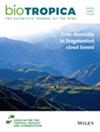残林与恢复林人工幼苗物理损伤的不同因子研究
IF 1.8
3区 环境科学与生态学
Q3 ECOLOGY
引用次数: 0
摘要
通过人工育苗实验,验证了物理损伤对恢复后热带森林自然更新的重要性。1年后,恢复林的人工苗破坏率(17.6%±2.6% SE)高于剩余林(12.7%±1.1% SE),主要原因是人工林的木屑脱落频率更高。脊椎动物的损害在残余森林中更为常见。本文章由计算机程序翻译,如有差异,请以英文原文为准。

Differing Agents of Physical Damage to Artificial Seedlings in Remnant and Restored Forests
We tested the importance of physical damage to seedlings as a bottleneck to natural regeneration in restored tropical forests using an artificial seedling experiment. After one year, more artificial seedlings had been damaged in restored forests (17.6% ± 2.6% SE) compared to remnant forests (12.7% ± 1.1% SE), primarily due to greater frequency of woody debris falling from planted trees. Vertebrate damage was more common in remnant forests.
求助全文
通过发布文献求助,成功后即可免费获取论文全文。
去求助
来源期刊

Biotropica
环境科学-生态学
CiteScore
4.10
自引率
9.50%
发文量
122
审稿时长
8-16 weeks
期刊介绍:
Ranked by the ISI index, Biotropica is a highly regarded source of original research on the ecology, conservation and management of all tropical ecosystems, and on the evolution, behavior, and population biology of tropical organisms. Published on behalf of the Association of Tropical Biology and Conservation, the journal''s Special Issues and Special Sections quickly become indispensable references for researchers in the field. Biotropica publishes timely Papers, Reviews, Commentaries, and Insights. Commentaries generate thought-provoking ideas that frequently initiate fruitful debate and discussion, while Reviews provide authoritative and analytical overviews of topics of current conservation or ecological importance. The newly instituted category Insights replaces Short Communications.
 求助内容:
求助内容: 应助结果提醒方式:
应助结果提醒方式:


